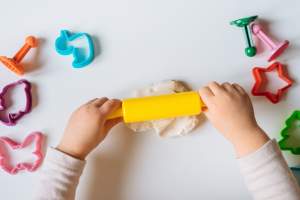We have all heard time and again how invaluable play is for all children, but having complex needs can present barriers that often makes it difficult for a child to fully enjoy the experience of the play opportunity that is being offered. The needs of our little ones at Hannah’s House vary a lot, so it’s often down to you, the parent or support worker, to understand the challenges and adapt the play to your individual child.
It’s important not to avoid a play opportunity just because you think your child can’t do something. Being able to do something isn’t what makes it enjoyable, it’s the process that brings enjoyment.
Play dough (there are many kinds) is a great example. Exploration and discovery are equally as important as it is for your child to be able to mould a masterpiece! Experimenting with different senses can be just as enjoyable for our children. Stimulating their senses strengthens connections in the brain creating new brain pathways which are important for all types of learning.
Play Dough Benefits
1. It improves social skills
When children work with others be that another child or even adults while playing with play dough they are getting great practice for the social setting. Sharing various colours, tools, and materials, as well as spending time together communicating and collaborating, allows children great practice with their social skills.
2. It’s calming for children
Squeezing play dough is great for helping calm down your children. Playing with the dough can help ease tension, release excess energy, improve focus, and express emotions. (maybe adding some calming oils will help here too)
3. Science and Maths
Making playdough with children is a great sensory activity. Creating a sensory tub with all the ingredients and tools inside can be a fun family activity. Conversation around what is in the box and what they are used for is a great vocabulary builder for all children. Allowing the children to feel each object, smell them even taste them where appropriate may help build awareness of their environment. You may think your just making play dough when in actual fact you are helping your child explore measuring, mixing, experimenting, and predicting what will happen next. Adding in colours and essences adds to the sensory experience.
4. It develops fine motor skills
Moulding play dough into different shapes helps build strength in our children’s hands. The acts of squishing, rolling, flattening, and more help your children develop muscles used in their hands for fine motor movements even if you are doing it hand over hand. You can introduce new vocabulary words such as those to describe the dough (cold, soft, lumpy). For our more complex children language to orientate them to their bodies is valuable too (I am putting the dough in your left hand. We are moving the fingers on your left hand etc).
5. It enhances hand-eye coordination
Along with play dough, children will use different materials and tools, such as rolling pins and cookie cutters to create. These tools, which come in a variety of sizes, develop your child’s hand-eye coordination by forcing them to manipulate the materials to fit their ideas. Again, our more complex children can explore this hand over hand with lots of communication support, helping them be a part of the fun. Don’t forget modelling to peers and siblings teaches them ways to interact with our children too. Our goal should always be to have other children interacting with our
There are many more benefits but none more important than…
6. COMMUNICATION
It has become a bit of a buzz word at Hannah’s House but the importance for our children to be exposed to as much language as possible can’t be underestimated. Most of the children under our care at Hannah’s House have communication as a goal under their NDIS plans so making the most of every opportunity to immerse our children in language is paramount. Our children need communication partners to assist them in gaining building communication and that might start with a play session and playdough!
PLAYDOUGH RECIPIES
Playdough
Ingredients: 1 Cup Flour, ¼ Cup Salt, 1 Tbsp Cream of Tartar, 2 Tbsp Oil, Mix with approx. 1 Cup water. Add couple drops of preferred food colour with the water. Can also add scent or glitter. Keep in a sealed bag after play and should keep for 2 weeks or more. Changing it up is a great way to keep your child interested.
Salt dough
Ingredients: 2 Cups Flour, 1 Cup Salt, approx. 1 Cup Water and mix. Can be air dried or baked on low heat in oven until hardened on both sides. This is good for keepsakes, eg hand and footprints. Can be painted once dry.
Cloud dough
Ingredients: 2 Cups Cornflour and 1 cup of either conditioner or body lotion. Makes a soft dough, smells nice with a fruity conditioner. If you only want a small amount halve the measurements.
Gloop
Ingredients: Cornflour 2 cups, water 1 cup. Food colouring can be added, if doing so add less water.



